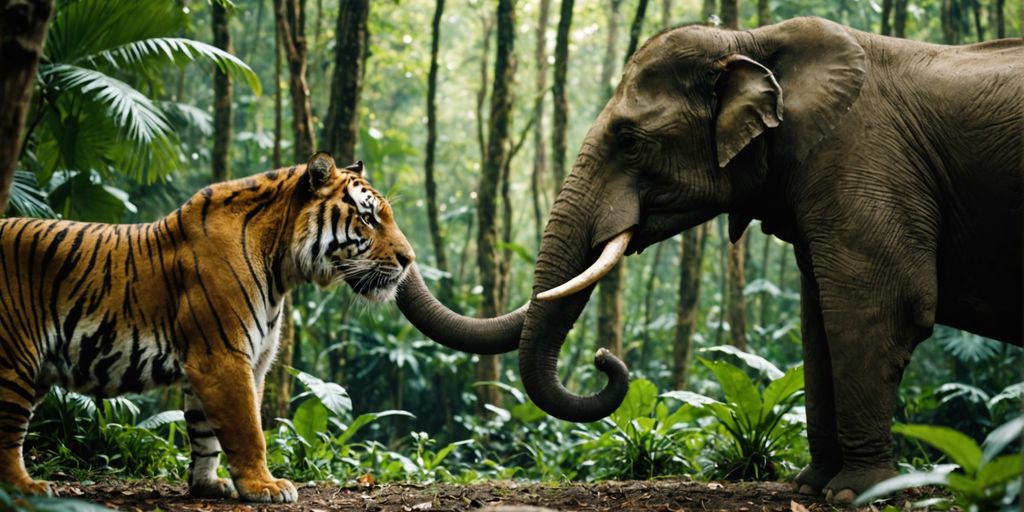Your Cart is Empty
🙏HELP US SAVE TIGERS!🐅 WE DONATE 1% OF OUR SALES TO WILDLIFE ORGANIZATIONS ( WWF ...)
Menu

🙏HELP US SAVE TIGERS!🐅 WE DONATE 1% OF OUR SALES TO WILDLIFE ORGANIZATIONS ( WWF ...)
India: The Land of the Tiger
May 28, 2021 13 min read

The Tiger or "Panthera tigris" is a magnificent species but is currently under tremendous threat of extinction. Despite all the hardships it has to face, it seems that one country remains the home of the species. India is a Tiger country; the big cat is deeply respected in this Asian state. An Indian environment is a perfect place for the Tiger to develop serenely.
Indeed, this country represents an open land of welcome for the striped fawn. The latter occupies a central place in the reserves, as well as in the Indian culture. Looking at India's love for the Tiger, one can only be grateful for the sacrifices made by this nation to conserve the felid.
The species we are going to talk about is the Bengal Tiger, the only subspecies that exists in India, but it is also the one that is the basis of the Tiger. As a way of thanking this country, Tiger-Universe has decided to share with you all its respect for India's sacred land.
The Tiger in the Indian environment
1) The Tiger's habitat

First of all, India is adored by the Tiger for its ancestral jungles, full of life. This environment is ideal for feeding this formidable predator. In India, the summers are long and very hot; this period is called the dry season. This means that during 2 to 3 months, the whole country will not know a single drop of rain.
Therefore, water will be highly scarce and will be located mainly in the enormous water points that have not been dried up by the season. Tigers, which are brilliant animals, will scrutinize these waterholes for prey because the herbivores will be obliged to go there sooner or later to drink. That's when the Tiger will attack!
Not so long ago, the Tiger territory formed a unit without borders on the whole of India. There were no barriers to the Tiger's passage from one end of the country to the other. Unfortunately, today the situation is quite different, the feline domain is fragmented, and the Tigers find themselves isolated in separate regions. This situation poses genetic diversity, as the Tigers now live in communities.
The regions where the Tiger is located are:
- The plains of northeast India
- The lowlands of the Himalayas
- The dry deciduous forests of the Indian peninsula
- The hills of the Western and Eastern Ghats
- The Sundarbans delta
The Tiger adapts to a wide variety of habitats and can readily move from one area to another if not blocked by human infrastructure. The mountainous lowlands are characterized by high humidity and thick mists. With the radiant sun and soft rocks, this environment is conducive to lush vegetation.
On the other side, the Indian rainforests are home to an impressive diversity of trees and insects. Although in the collective mind, this setting seems ideal for the Tiger, thanks to abundant water and ample cover provided by the trees. In reality, the lack of large herbivores in the jungle makes it very rare to come across a Tiger in such a place.

There are high grasses at the edge of these forests, which are a much more exciting place for the big cat. These are bordered by the many rivers that join the vast Indian plains. The Tiger loves these places because it can easily hide in the high grass to surprise its future victims.
However, the villagers often burn these meadows to create space for the cattle. This vegetation resembles more than the savannah, with golden grasses and dry earth. The Indian savannah is full of creatures, such as the sambar, the buffalo, the gaur, the elephant.
Tigers enjoy all these animals that occupy this environment. Elephants and hippos are found in the swampy areas of the wet savannahs. The short distances between the dry and swampy savannahs are ideal for the Tiger. This combination of the terrain is perfect for hunting, as the Tiger can roam between these two areas to find its meal.
India can easily be compared to Africa because of its rich and varied wildlife. It is the country of the great game par excellence; 4 of the biggest animals of the world occupy the Indian lands:
- The elephant
- The hippopotamus
- The rhinoceros
- The buffalo
Moreover, this sacred land is the only place on earth where the Tiger and the Lion are found on the same territory. Just having the King of the Savannah and the King of the Jungle on the same land is enough to make India a true sanctuary of the animal kingdom.
2) The prey

In addition to being a perfect habitat for the Tiger, India is full of all kinds of resources to feed this fearsome carnivore. This country has a wide range of prey, which the striped felid feasts on. Among them, we find the sambar, the deer, the chital, the elephant, or the buffalo, to name but a few.
All these preys are located in the same geographical area; they all have a physique and very different eating habits. Moreover, they avoid competing with each other and live in harmony. They need this union to survive the supernatural power of the Tiger!
We will make a small presentation of the six species that the Tiger feeds the most in India.
THE SAMBAR

It is the largest deer in the world; it is found on all the Tiger lands. And unfortunately for him, it is the prey that the big cat loves the most. The sambar feeds as well on the foliage of the trees as on the grass on the ground. The sambar emits an alarm call when it sees the Tiger or feels in danger.
THE CHITAL

It also belongs to the deer family, but it is much less imposing than its cousin, the sambar. The Chital feeds mainly on short and soft grasses but also dead leaves. It can stand on its hind legs to grab leaves and fruits from trees.
The Chital lives in open forests because it can rest under long-leafed trees out of the sun. The Tiger loves this animal. However, it is not very nutritious for the big carnivore.
THE DAIM

Better known as the howler deer, this animal is found in a wide variety of habitats, from the mountainous regions to the deciduous forests of the Indian plains. But it does not live in the drylands and swamps of the Sundarbans.
It is not a much sought-after prey by the Tiger except when the latter is hungry. Because the deer is not easy to hunt for the Tiger, moreover, it represents a small quantity of meat for a rather consequent effort to come to an end.
THE BUFFLE

It is the largest bovine globally; it is comparable in size to the elks of Africa. It is an endemic species of Asia; India has many buffaloes on its territory. This animal is a lover of swamps, where it spends most of its time.
On the other hand, although it is unassailable for the Tiger when it is in the water. The latter becomes vulnerable to the striped predator in the open land because his slowness and terrible sight make him the prey of choice for the Tiger.
THE LIPPU BEAR

With a size and a physique much less impressive than its cousin, the Brown Bear, the Lippo Bear is part of the Tiger's prey. The latter lives in the forests of southern India, a territory in which the great Tiger evolves!
The Lippo Bear is also nicknamed the Honey Bear because of its ability to climb to the top of trees until reaching the bees' nests. This species is the smallest bear species, ranging from 60 to 135 kg maximum. Thus, the Tiger can rub shoulders with this much smaller carnivore.
However, even if the striped fawn can attack Lippu bears, this happens only on rare occasions. Indeed, because of its size and ability to defend itself, it is much less straightforward for the Tiger to defeat it than other deer. Attacks of this kind occur only when the Tiger is starving because it has no choice but to kill the bear if it wants to survive.
THE ELEPHANT

With its enormous weight, the elephant constitutes an exciting prey for the Tiger. The latter live in herds; they feed mainly on the gathering of trees. This activity creates actual paths through the undergrowth, putting a large part of the branches, lianas, and climbing plants on the ground.
As soon as a herd of elephants leaves an area, the other forest animals come to feed on the plants on the ground. Tigers are diligent in following the movements of these herds to prey on the ungulates feeding on the remains.
However, although there are many accounts of Tigers killing elephants, it turns out that the beast rarely attacks elephants because hunting elephants is a hazardous activity for the big Tiger. It will target children first, which are much easier prey to kill if it decides to attack.
Finally, India is a prosperous land for the Tiger. The latter has a multitude of prey to feed on. Moreover, we notice that chitals and sambars exist in great quantity on these territories. The Tiger is thus necessary to this environment to keep an ecological balance and avoid destroying the plants by these herbivores.
Come and discover India with our magnificent Indian Tiger Paintings, right here. ⤵️
The will to protect the feline
1) A fragile species

The Tiger is a species that has been endangered for nearly 50 years. The reasons for its disappearance are diverse, but Man is the main responsible. Indeed, the Tiger has no predator in its environment except for humans! Poaching, destruction of its habitat, and lack of prey to hunt are the significant causes causing the Tiger's extinction.
The feline is highly sought after by poachers for its fur and its organs used in traditional Chinese medicine. The mass killing of these wild animals fuels the illegal trade. In addition, it destroys the ecosystem of rugged environments, allowing the proliferation of certain mammals thanks to the absence of the Tiger. Entire regions are being disrupted because of this trade and wiping out Tiger populations.
In the last 30 years, the population of the striped cat has decreased by half from about 7000 tigers in 1990 to 3500 today. Before, the Bengal Tiger lived on most of the Asian continent. Today, it is isolated in India and is found in some border countries such as Nepal.
The destruction of its habitat forces the Bengal Tiger to move around the Indian continent constantly. In this way, it must continuously adapt to changing environments; those who fail to do so will perish. In addition, the local Indian populations are increasingly suspicious of the Tiger. Because the villagers are settling in its territory and it defends itself by attacking the men. Thus, real hunts for Tigers are implemented to get rid of the largest of the felines.
We can see that the Tiger is a highly fragile species, which is very sensitive to the moods of men. This is why protective measures must be taken. Fortunately, India has taken the lead in this fight, and we will see this right away.
2) The protection measures put in place

The critical situation of the Tiger very quickly alarmed the Indian government, which promptly voted numerous protectionist measures. The main one is the Project Tiger which came into being on April 1st, 1973, and is still in place today. The main objective of this plan is to maintain a viable population of Tigers in the wild. India has always favored life in the wild for endangered species rather than keeping them in captivity in zoos.
Through the fight against poaching, this project wants to allow the Tigers to live without fear on their ancestral lands. At the time, poaching was a real scourge in India and seriously threatened the Bengal Tiger. Today, thanks to Project Tiger, this activity is less and less popular but also more and more severely punished.
The expansion of the reserves was also a priority of the Indian government, as the villagers were encroaching too much on the territory of the King of the Jungle. Once again, Project Tiger was a success on this point, creating gigantic spaces for the beast to evolve serenely. These advances will have forced more than 50,000 Indian villagers to change their living place to give more space to the Tiger.
The Corbett National Park is a perfect example of the success of this project. The project's success can be seen in the extent to which the Tiger can live unhindered in its natural environment. The Tiger range, which can be up to 150km², is very often respected. These Indian reserves are becoming real animal sanctuaries, where the Tiger is the King!
3) The current situation

Today, it seems that India's past efforts are starting to pay off. The "All India Tiger" report published in 2018 estimates the country's total population at around 3,000 Bengal Tigers. These results are more than encouraging, as, in recent years, the government has seen an increase in the number of Tigers for the first time.
However, there is still room for improvement to make Project Tiger even more effective. Other studies show that invasive plant species threaten 20% of the reserves. These plants, which can be considered weeds, are not edible by herbivores and spread at a rather alarming rate.
Not only that, but other long-standing threats continue to exist, such as poaching and pressure from villagers on tiger habitat. Although these problems have been mostly reduced, they continue to take their toll. The lack of forestry staff is a real problem in the Indian reserves.
However, it was expected that this project would not have eradicated the threat of extinction of certain animal species. It is undeniable that India is the most favorable habitat for the Tiger. This country has the most enormous and safest territory in the world to ensure the survival of this large carnivore.
Today, India is home to over 60% of the world's tiger population. In addition, there are 50 Tiger reserves in India, which is about 2.20% of the country's total area. This part dedicated to the Tiger represents an area twice that of Switzerland, that's to say!
Even if the Western and Eastern Ghats are subject to mass poaching, India is constantly putting measures to limit this massacre. And these measures seem to be paying off if the results of the WWF studies are to be believed. The Bengal Tiger is in a more than encouraging position, as long as India does not change its policy what all our team hopes greatly!
The place of the Fawn in the Indian culture
1) The love of traditions for the Tiger

In India, the Tiger is a sacred animal, cow, or rat. We feel real love for him through the whole Indian culture. The big cat is associated with the north of the country and the god Shiva. It is a true symbol of wealth and was worshipped by the Indian royalty of the time.
The Tiger was also ridden by the deity Maa Durga in her greatest battles. Durga is the wife of Shiva, the goddess of peace in Hindu mythology. In ancient representations, the Tiger appears as the most faithful servant of the Indian goddess. He fights at her side against the demon-buffalo Mahishasura and represents the unlimited power of his mistress.
The Indian people revere the Tiger and pray for its protection and the survival of the species. For them, the feline represents a direct link between the human kingdom and the animal kingdom. For the Tiger has the reputation of having a man's soul in a predator's body. It is the perfect transition between the spirit of nature and the society of human beings.
Thanks to Indian traditions, the Tiger lives in perfect harmony and maintains good relations with his neighbors, the villagers. However, this reciprocal love is quickly transformed into fear, even hatred towards the beast.
2) Admiration also hides fear

Because of the numerous attacks of Tigers in India, the latter has acquired the reputation of a man-eating animal. This name, which many Westerners know today, comes straight from the Sundarbans region in India. This swampy area has been the scene of many massacres caused by the Bengal Tiger. The Bengal Tiger kills dozens of people every year in this area, which has created an actual fear of the cat among the local population.
But contrary to what most people think, the Tiger does not kill for free, quite the contrary. This animal is very territorial; it sees with a very evil eye the activity of the Indians who come to settle on its territory. That's why he starts to attack them to understand that they are not welcome on the part of the King of the jungle!
In Indian folklore, it is said that if a Tiger tastes human flesh, he will take a liking to it and will only eat humans. This legend is not so far from reality; several studies even prove that a Tiger who has attacked a human being will have less trouble doing it again.
This is because Tigers are usually very afraid of humans. However, once they realize that we are easy prey, then they get used to an easy and very nourishing hunt by killing human beings. But beware, the legend that the Tiger has a taste for human flesh is unfounded and is more of a belief than a science.
3) The massacre in the Sundarbans

In the Sundarbans region, the Tigers always attack by stealth. They attack humans from behind and even chase them into their village. The villagers are so terrorized that they have developed many techniques to make the Tiger run away.
The most common one is to put a mask on the back of their face when they go on an expedition into the swamps. According to them, the Tiger would not attack as long as the Man sees him, so the mask would make him think he is spotted. But this technique is not proven because it seems that the Tiger manages to see when it is spotted by analyzing the behavior of its potential prey.
The Tiger often attacks humans who enter its territory and linger too long. The proximity of populations with the Bengal Tiger creates real massacres because the Tiger is above all a territorial animal. There can be no cohabitation between Man and Tiger; it is necessary to leave him a piece of territory and live away from the king of the jungle. By taking these measures, we will not have any more Tiger attacks towards the Man to declare.
However, the Tiger's reputation as a man-eater should be put into perspective because many of the attacks are warnings. There are about ten victims per year for several hundred episodes of Tigers. Knowing the vulnerability of humans to such a predator, we can only conclude that the Tiger rarely attacks with the will to kill.
To summarize

India is truly the only country of the Tiger. Whether it is in the culture, the will to protect the species, or in the habitat it can offer, this country is a paradise for the striped feline. Even if things have not always been easy because of the many problems caused by poaching, India remains an example of animal conservation.
Countries worldwide should follow the example of the measures and actions put in place by the Indian government. In a world where western nations are struggling to conserve the few species that inhabit their territories, the East represents a true cradle of animal life. India is leading the way for a more responsible economy that pays attention to ecological issues.
Russia and China should follow these actions if they hope to conserve the Siberian Tiger. This subspecies has been critically endangered for years, with a population of fewer than 50 specimens. Unfortunately, India cannot do the work on a territory that is not it's own. Global awareness needs to occur so that the different species of Tigers around the world can survive.
"Become the change you want to see in the world."
Gandhi
Let the zen-like atmosphere of the East into your own home with our Tiger Stickers. ⤵️
Also in Tiger Blog

Sloth Bear vs Tiger: Who Would Win?
July 13, 2024 7 min read
Explore the thrilling showdown between a sloth bear and a tiger, analyzing their strengths, behaviors, and survival tactics.
Read More
Tiger vs Elephant: Who Reigns Supreme in the Animal Kingdom?
July 13, 2024 7 min read
Explore why elephants usually triumph over tigers in the wild, highlighting their size, strength, and defensive prowess.
Read More
Epic Battle: Polar Bear vs Tiger, who win?
July 11, 2024 8 min read
Epic showdown: Polar Bear vs Tiger. Discover who would win in this thrilling battle of nature's fiercest predators.
Read More
